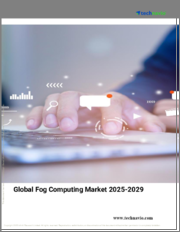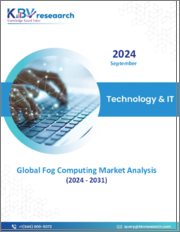
|
시장보고서
상품코드
1596947
세계의 포그 컴퓨팅 시장 : 규모, 점유율, 성장 분석, 유형별, 용도별, 지역별 - 산업 예측(2024-2031년)Fog Computing Market Size, Share, Growth Analysis, By Type (Hardware, Software), By Application (Connected Vehicle, Building & Home Automation) By Region - Industry Forecast 2024-2031 |
||||||
세계 포그 컴퓨팅 시장 규모는 2022년 8,550만 달러로 2023년 1억 2,666만 달러에서 2031년까지 43억 1,438만 달러로 성장해 예측 기간(2024-2031년)의 CAGR은 48%로 나타날 전망입니다.
포그 컴퓨팅 시장은 데이터 보안에 대한 인식을 높이고 대역폭 제약, 기존 IoT 시스템의 단순한 용도에 대한 의존도를 높이는 등 다양한 요인이 겹치고 강력한 성장을 이루고 있습니다. 많은 IoT 장치가 보급됨에 따라, 특히 데이터 스트리밍을 통한 시스템 응답 시간 향상 및 보안 대책 강화 화가 요구되고 있습니다. 포그 컴퓨팅은 증강현실(AR) 및 IoT 용도의 네트워크 지연을 최소화하고 실시간 데이터 처리를 용이하게 하는 동시에 분석을 위해 대규모 데이터 세트를 클라우드로 전송 필요성을 줄이는 능력이 특징입니다. 이 분산 방식은 컴퓨팅 리소스를 데이터 생성 장치에 가깝게 만듭니다 이를 통해 연결되는 IoT 장치가 증가함에 따라 데이터 처리에 대한 근접성에 대한 요구가 높아지지만 표준화 된 프로토콜이나 전문 지식이 없으므로 최종 사용자가 데이터를 검색하고 통합을 효과적으로 관리하는 능력이 낮기 때문에 시장은 큰 과제에 직면 해 있습니다. 또한 부적절한 분석, 에지 장치에 대한 계산 능력 확장의 제한, 연결성, 지연 및 대역폭을 둘러싼 문제로 인해 시장 성장을 더욱 제한합니다. 시장 상황이 진화함에 따라 잠재력을 극대화하고 지속적인 시장 확대를 달성하려면 이러한 문제를 해결하는 것이 중요합니다.
목차
소개
- 조사의 목적
- 조사 범위
- 정의
조사 방법
- 정보 조달
- 2차 데이터와 1차 데이터의 방법
- 시장 규모 추정
- 시장의 전제조건과 제한
주요 요약
- 세계 시장 전망
- 공급과 수요의 트렌드 분석
- 부문별 기회 분석
시장 역학과 전망
- 시장 개요
- 시장 규모
- 시장 역학
- 성장 촉진요인과 기회
- 억제요인과 과제
- Porter's Five Forces 분석과 영향
- 경쟁 기업간 경쟁 관계
- 대체품의 위협
- 구매자의 협상력
- 신규 진입업자의 위협
- 공급기업의 협상력
주요 시장 인사이트
- 주요 성공 요인
- 경쟁도
- 주요 투자 기회
- 시장 생태계
- 기술의 진보
- 규제 상황
- 특허 분석
- 사례 연구 분석
- PESTEL 분석
- 스타트업 분석
- 시장의 매력 지수
세계의 포그 컴퓨팅 시장 규모 : 유형별, CAGR(2024-2031년)
- 하드웨어
- 게이트웨이
- 라우터 스위치
- IP 캠코더
- 센서
- 마이크로 데이터 센서
- 소프트웨어
세계의 포그 컴퓨팅 시장 규모 : 용도별·CAGR(2024-2031년)
- 커넥티드카
- 스마트 그리드
- 스마트 시티
- 커넥티드 헬스케어
- 스마트 제조
- 기타
세계의 포그 컴퓨팅 시장 규모:지역별·CAGR(2024-2031년)
- 북미(유형별, 용도별)
- 미국
- 캐나다
- 유럽(유형별, 용도별)
- 영국
- 독일
- 스페인
- 프랑스
- 이탈리아
- 기타 유럽
- 아시아태평양(유형별, 용도별)
- 중국
- 인도
- 일본
- 한국
- 기타 아시아태평양
- 라틴아메리카(유형별, 용도별)
- 브라질
- 기타 라틴아메리카
- 중동 및 아프리카(유형별, 용도별)
- GCC 국가
- 남아프리카
- 기타 중동 및 아프리카
경쟁 정보
- 상위 5개사 비교
- 주요 기업의 시장 포지셔닝(2023년)
- 주요 시장 기업이 채용한 전략
- 시장의 최근 동향
- 기업의 시장 점유율 분석(2023년)
- 주요 기업의 기업 프로파일
- 기업 개요
- 제품 포트폴리오 분석
- 기업의 부문별 점유율 분석
- 수익의 전년대비 비교(2021-2023년)
주요 기업 프로파일
- Cisco Systems Inc.
- IBM Corporation
- Intel Corporation
- Microsoft Corporation
- ARM Holdings PLC(SoftBank)
- Fujitsu Limited
- Dell Technologies Inc.
- Schneider Electric SE
- GE Digital
- Toshiba Corporation
- ADLINK Technology Inc
- Cradlepoint Inc.
- MachineShop Inc
- Zebra Technologies Corporation
- Hitachi Vantara Corporation
결론과 권고
JHS 24.12.06Global Fog Computing Market size was valued at USD 85.5 million in 2022 and is poised to grow from USD 126.66 million in 2023 to USD 4314.38 million by 2031, growing at a CAGR of 48% in the forecast period (2024-2031).
The fog computing market is experiencing robust growth driven by a confluence of factors, including heightened awareness of data security, bandwidth constraints, and a rising reliance on simple applications within existing IoT systems. The proliferation of data-intensive IoT devices necessitates improved system response times and fortified security measures, particularly through data streaming. Fog computing is characterized by its ability to minimize network latency for augmented reality (AR) and IoT applications, facilitating real-time data processing while reducing the need to transfer large datasets to the cloud for analysis. This decentralized approach brings computing resources closer to data-generating devices, thereby addressing the increasing demand for proximity in data processing as the number of connected IoT devices expands. However, the market faces significant challenges, including the absence of standardized protocols and expert knowledge, which hamper end-user capability to effectively manage data retrieval and integration. Moreover, fog devices are often deployed in public settings, leaving them vulnerable to interference. Additionally, obstacles such as inadequate analytics, limitations in extending computational capacities to edge devices, and issues surrounding connectivity, latency, and bandwidth further constrain market growth. Reliability and cost efficiencies related to air conditioning also pose concerns. As the fog computing landscape evolves, addressing these challenges will be critical for maximizing its potential and achieving sustained market expansion.
Top-down and bottom-up approaches were used to estimate and validate the size of the Global Fog Computing market and to estimate the size of various other dependent submarkets. The research methodology used to estimate the market size includes the following details: The key players in the market were identified through secondary research, and their market shares in the respective regions were determined through primary and secondary research. This entire procedure includes the study of the annual and financial reports of the top market players and extensive interviews for key insights from industry leaders such as CEOs, VPs, directors, and marketing executives. All percentage shares split, and breakdowns were determined using secondary sources and verified through Primary sources. All possible parameters that affect the markets covered in this research study have been accounted for, viewed in extensive detail, verified through primary research, and analyzed to get the final quantitative and qualitative data.
Global Fog Computing Market Segmental Analysis
Global Fog Computing Market is segmented by Type, by Application, and by Region. Based on Type, the market is segmented into Hardware, and Software. Based on application, the market is segmented into Connected Vehicle, Building & Home Automation, Smart Energy, Smart Manufacturing, Connected health, Securities & emergencies, and others. Based on region, the market is segmented into North America, Europe, Asia Pacific, Latin America and Middle East & and Africa.
Driver of the Global Fog Computing Market
The fog computing market is experiencing significant growth fueled by the rising demand for real-time data processing, especially within IoT (Internet of Things) applications. Traditional cloud computing, while effective for various tasks, often struggles with latency and bandwidth limitations, particularly in scenarios requiring immediate data analysis and response. Fog computing mitigates these challenges by enhancing response times, reducing latency, and optimizing bandwidth usage, making it particularly suitable for critical applications such as autonomous vehicles, industrial automation, and smart city initiatives. As businesses increasingly recognize the importance of real-time decision-making and operational efficiency, the adoption of fog computing solutions continues to expand steadily.
Restraints in the Global Fog Computing Market
The global fog computing market faces several restraints, with security and privacy concerns being a major challenge. Issues such as data breaches and unauthorized access can hinder the widespread adoption of fog computing solutions. Furthermore, stringent legal regulations regarding data privacy, including GDPR and HIPAA, impose significant compliance requirements, complicating the implementation of these solutions. Since data is processed and stored at the network's edge, the number of potential access points for cyberattacks rises, necessitating organizations to adopt comprehensive security measures. This complex landscape necessitates careful navigation to ensure both security and compliance while leveraging fog computing technologies.
Market Trends of the Global Fog Computing Market
The Global Fog Computing market is witnessing a significant shift towards edge analytics and intelligence, driven by the integration of machine learning and artificial intelligence into data processing solutions. This trend enables businesses to enhance their data analysis capabilities, facilitating predictive maintenance and real-time monitoring, especially in sectors like manufacturing. The ability to generate immediate insights and responses contributes to improved operational efficiency and minimized downtime, positioning edge analytics as a critical component of modern fog computing infrastructures. As industries increasingly recognize the value of these capabilities, the demand for advanced edge-based solutions is anticipated to grow, further propelling the fog computing market.
Table of Contents
Introduction
- Objectives of the Study
- Scope of the Report
- Definitions
Research Methodology
- Information Procurement
- Secondary & Primary Data Methods
- Market Size Estimation
- Market Assumptions & Limitations
Executive Summary
- Global Market Outlook
- Supply & Demand Trend Analysis
- Segmental Opportunity Analysis
Market Dynamics & Outlook
- Market Overview
- Market Size
- Market Dynamics
- Driver & Opportunities
- Restraints & Challenges
- Porters Analysis & Impact
- Competitive rivalry
- Threat of substitute
- Bargaining power of buyers
- Threat of new entrants
- Bargaining power of suppliers
Key Market Insights
- Key Success Factors
- Degree of Competition
- Top Investment Pockets
- Market Ecosystem
- Technological Advancement
- Regulatory Landscape
- Patent Analysis
- Case Study Analysis
- PESTEL Analysis
- Startup Analysis
- Market Attractiveness Index
Global Fog Computing Market Size by Type & CAGR (2024-2031)
- Hardware
- Gateways
- Routers & Switches
- IP Video Cameras
- Sensors
- Micro Data Sensors
- Software
Global Fog Computing Market Size by Application & CAGR (2024-2031)
- Connected vehicles
- Smart Grids
- Smart Cities
- Connected Healthcare
- Smart manufacturing
- Others
Global Fog Computing Market Size by Region & CAGR (2024-2031)
- North America, (by Type, by Application)
- US
- Canada
- Europe, (by Type, by Application)
- UK
- Germany
- Spain
- France
- Italy
- Rest of Europe
- Asia-Pacific, (by Type, by Application)
- China
- India
- Japan
- South Korea
- Rest of Asia Pacific
- Latin America, (by Type, by Application)
- Brazil
- Rest of Latin America
- Middle East & Africa, (by Type, by Application)
- GCC Countries
- South Africa
- Rest of Middle East & Africa
Competitive Intelligence
- Top 5 Player Comparison
- Market Positioning of Key Players, 2023
- Strategies Adopted by Key Market Players
- Recent Developments in the Market
- Company Market Share Analysis, 2023
- Company Profiles of All Key Players
- Company Details
- Product Portfolio Analysis
- Company's Segmental Share Analysis
- Revenue Y-O-Y Comparison (2021-2023)
Key Company Profiles
- Cisco Systems Inc.
- Company Overview
- Business Segment Overview
- Financial Updates
- Key Developments
- IBM Corporation
- Company Overview
- Business Segment Overview
- Financial Updates
- Key Developments
- Intel Corporation
- Company Overview
- Business Segment Overview
- Financial Updates
- Key Developments
- Microsoft Corporation
- Company Overview
- Business Segment Overview
- Financial Updates
- Key Developments
- ARM Holdings PLC (SoftBank)
- Company Overview
- Business Segment Overview
- Financial Updates
- Key Developments
- Fujitsu Limited
- Company Overview
- Business Segment Overview
- Financial Updates
- Key Developments
- Dell Technologies Inc.
- Company Overview
- Business Segment Overview
- Financial Updates
- Key Developments
- Schneider Electric SE
- Company Overview
- Business Segment Overview
- Financial Updates
- Key Developments
- GE Digital
- Company Overview
- Business Segment Overview
- Financial Updates
- Key Developments
- Toshiba Corporation
- Company Overview
- Business Segment Overview
- Financial Updates
- Key Developments
- ADLINK Technology Inc
- Company Overview
- Business Segment Overview
- Financial Updates
- Key Developments
- Cradlepoint Inc.
- Company Overview
- Business Segment Overview
- Financial Updates
- Key Developments
- MachineShop Inc
- Company Overview
- Business Segment Overview
- Financial Updates
- Key Developments
- Zebra Technologies Corporation
- Company Overview
- Business Segment Overview
- Financial Updates
- Key Developments
- Hitachi Vantara Corporation
- Company Overview
- Business Segment Overview
- Financial Updates
- Key Developments

















